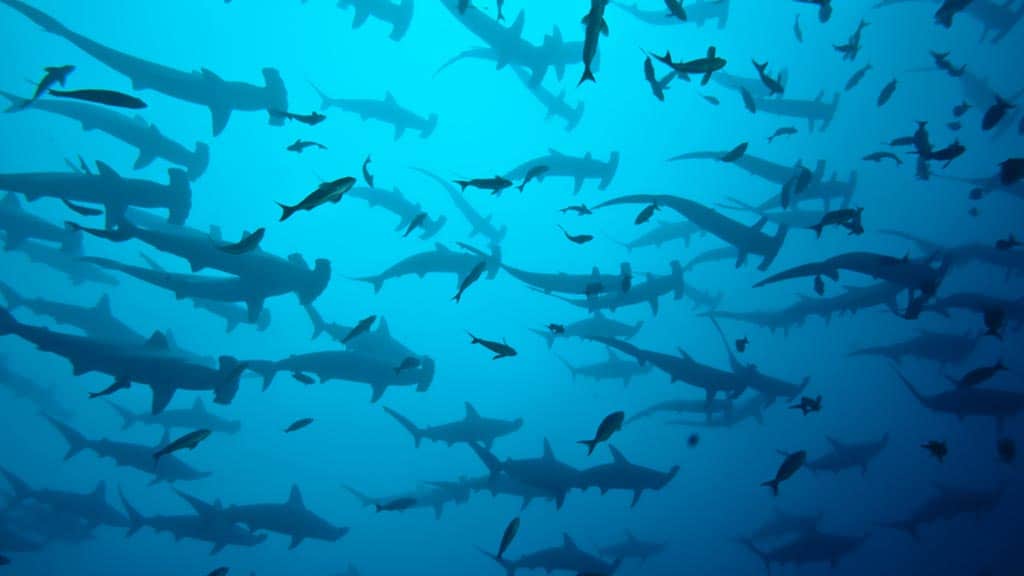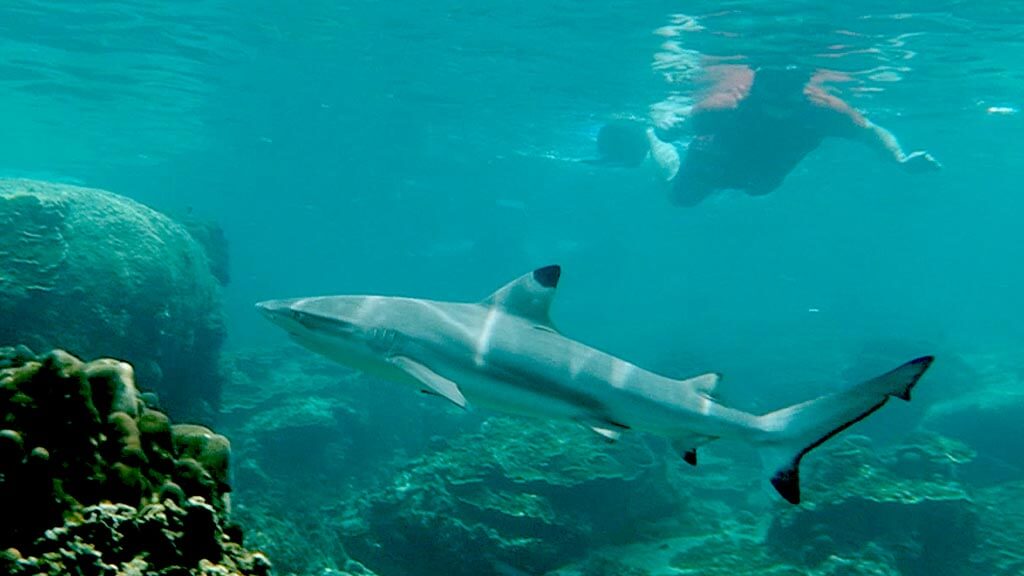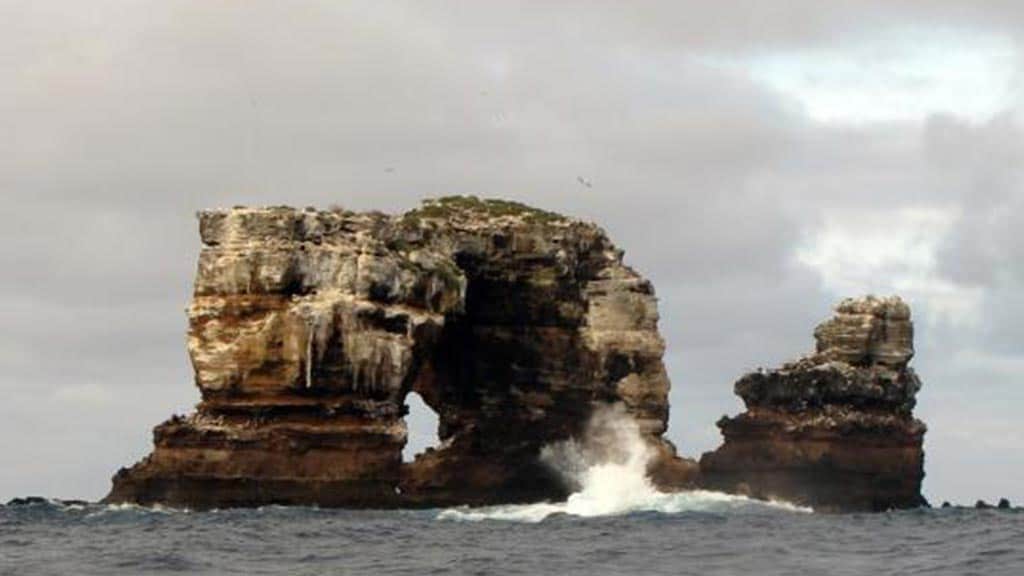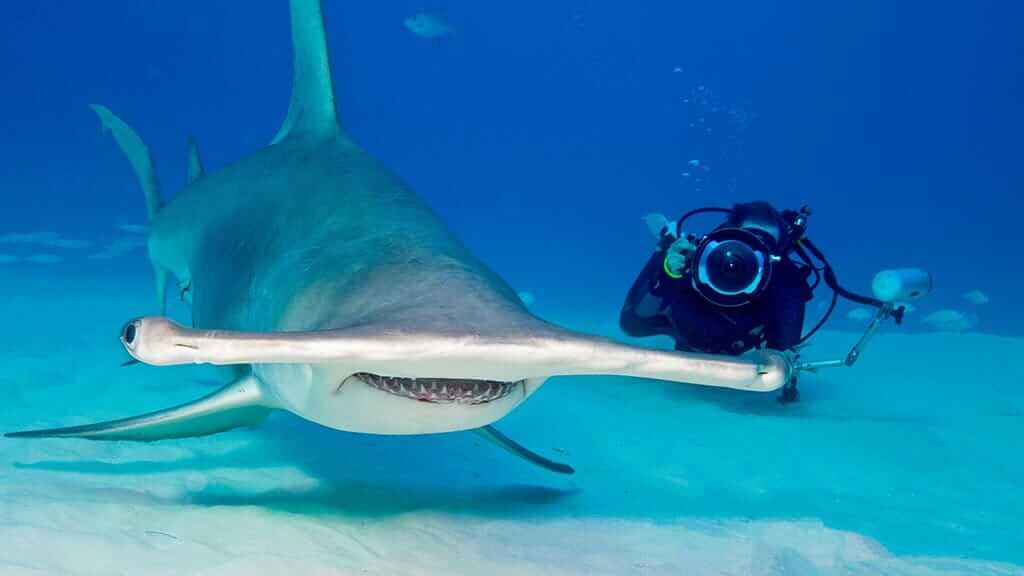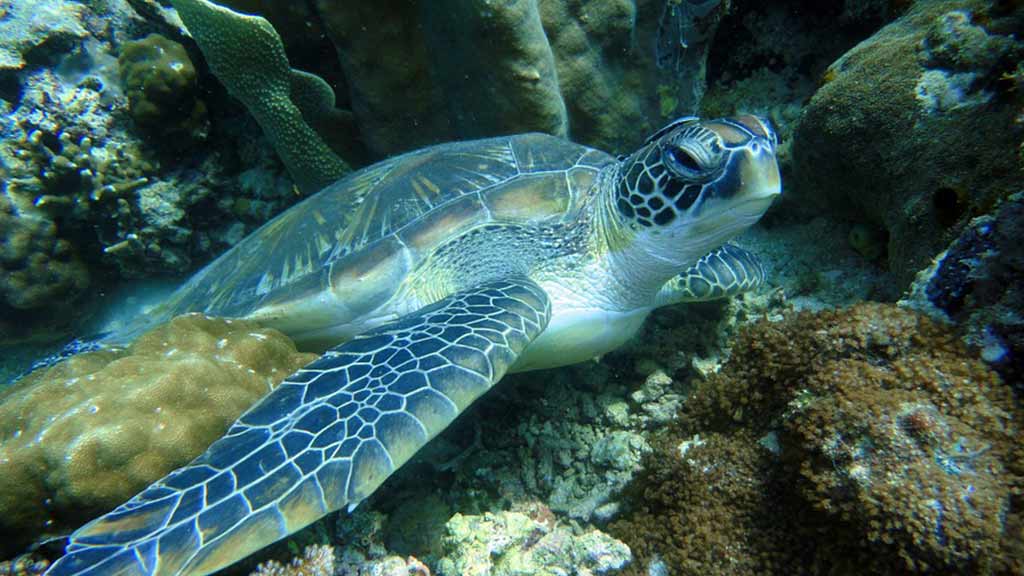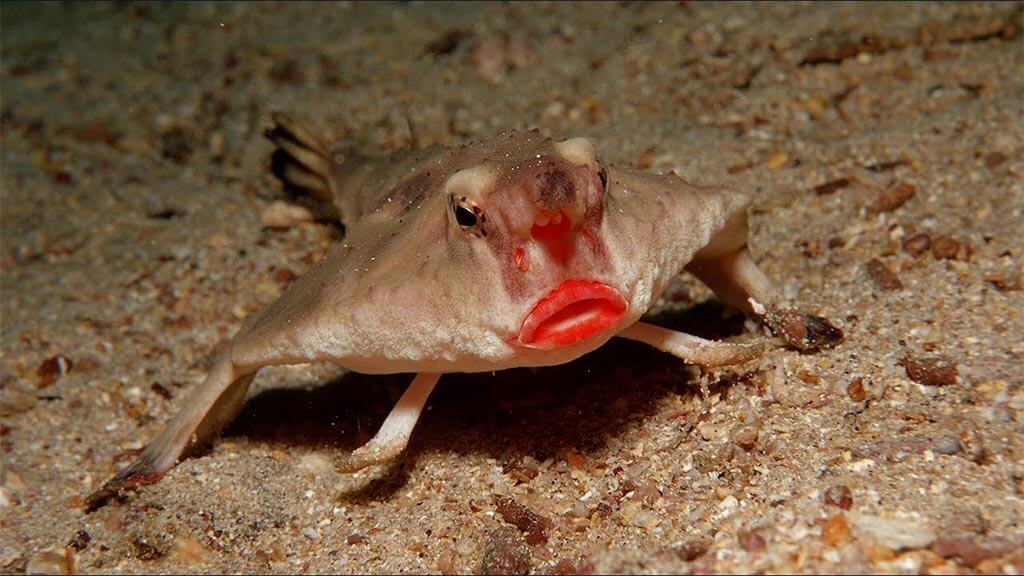Darwin Island & Wolf Island
Let’s begin by putting Wolf and Darwin Island into perspective. The Galapagos Islands are widely known as one of the 7 Underwater Wonders of the World. On top of this, Wolf and Darwin Islands are the VERY BEST dive sites in the Galapagos archipelago. So, it's no wonder that divers are chomping at the bit to dive here. We are talking world-class scuba action!
The area surrounding Wolf and Darwin Island is visited by an unprecedented variety of marine creatures each year. Scalloped hammerheads, whale sharks, dolphins, rays, and an overwhelming crowd of tropical fish hold court amidst the coral reefs and volcanic cliffs. In fact, these waters boast the largest shark biomass on the planet!
So, the islands of Darwin and Wolf are perfect for experienced divers who are seriously passionate about their sport. Add interesting volcanic rock formations and landscapes, plus abundant marine birds nesting on the cliffs, and you begin to appreciate just what makes Darwin Island and Wolf Island so special.
Keep reading for everything you need to know to plan your visit to Darwin Island Galapagos and nearby Wolf Island. What marine creatures to spot? Which dive sites to visit? Plus, when is the best time to see Hammerheads and Whale Sharks here?
SECURE YOUR GALAPAGOS TRAVEL
Get a FREE personalised quote todayWolf & Darwin Island Galapagos Wildlife Highlights:
• Boasting the largest shark biomass on the planet, Wolf and Darwin Galapagos islands are THE place to come to dive face to face with sharks. Shark species to spot here include Scalloped Hammerheads, Galapagos sharks, white-tip and black-tip reef sharks, Dusky and Silky sharks, plus much more. In very few other dive sites on earth will you find such a large volume and diversity of sharks together at once.
• Giants of the Deep, Whale sharks are the largest shark species in the world’s oceans today. Darwin’s Arch at Darwin Island is a breathtaking dive site to watch these magnificent beasts filter feeding.
• A diverse range of Galapagos Rays feed in the rich waters around Darwin and Wolf islands. Huge manta rays make a great tick on any diver's bucket list, while Golden rays, Eagle rays, and Stingrays are also common sightings.
• Tropical reef fish abound here, with Sailfish, Barracuda, Scorpionfish, Hogfish, Parrotfish, and Trumpetfish to name but a few. Also, keep an eye open for the rare red-lipped Batfish on the sea bed.
• Dolphins are commonly sighted in the open ocean around Darwin Island and Wolf Island, feeding on schools of fish.
• It’s not only about underwater action, the cliffs of Darwin Arch are a popular nesting area for marine birds such as the Nazca booby, Red-footed booby, Swallow-tailed gull, and the Sooty tern. Land birds include the rare Vampire Finch and Darwin’s Mockingbird.
About Darwin Island Galapagos
English Name: Culpepper
Ecuadorian Name: Darwin Island
Total Area: 0.9 sq miles
Population: zero (uninhabited)
Darwin Island is of course named in honor of famous British botanist Charles Darwin, whose visit helped put the Galapagos Islands onto the map. The original English island name comes from another English naturalist, Lord Culpepper.
Darwin Island is the northernmost landfall of the Galapagos archipelago, located more than 100 miles to the northwest of Isabela Island. Darwin Island is in fact an extinct volcano thought to have formed from the ocean floor sometime between 400,000 and 1.6 million years ago.
About Wolf Island Galapagos
English Name: Wenman
Ecuadorian Name: Wolf Island
Total Area: 1.1 sq miles
Population: zero (uninhabited)
Wolf Island was named after Franz Theodor Wolf, a German geologist and explorer who spent considerable years mapping, surveying, and studying the geology of the Galapagos Islands.
Like Darwin Island, Wolf is an extinct submarine volcano whose peak emerges from the ocean to form the island we see today. Wolf Island is surrounded by dive sites of volcanic shelves, cliffs, and underwater caves, teeming with diverse marine creatures.
One famous and unusual Wolf Island Galapagos resident to look out for is the Vampire Finch (also known as the Sharp-backed Ground Finch). Wolf Island is extremely dry throughout much of the year, so the enterprising Vampire Finch has developed a unique way to survive here. Remarkably they have adapted to suck the blood of larger marine birds such as boobies. They literally pierce a hole in the booby’s skin to drain blood, often queueing together to take turns in this macabre feeding. The Vampire Finch has also been observed eating unprotected booby eggs for moisture.
Where is Darwin Island?
As you can see in the above Darwin Island Galapagos Map, both Darwin and Wolf Islands are the most remote of the archipelago, located far to the northwest of the main group of islands.
Given the remote location, these waters are particularly vulnerable to illegal fishing. So in 2008, the Galapagos National Park Authority inaugurated a floating base at Wolf Island, to help patrol and protect this important marine site.
GET FREE ADVICE
From a Galapagos destination expert todayHow to Visit Wolf & Darwin Islands?
Due to their remote location, the area around Wolf and Darwin Island is the most challenging to visit in the Galapagos Archipelago.
Regular Galapagos Cruises don’t head out this far, so the only way to experience these islands is on a live-aboard Galapagos Diving Cruise. Specialist dive yachts like the Aggressor III, Galapagos Sky, Humboldt Explorer, and Aqua run dedicated Galapagos dive itineraries up to Darwin and Wolf Islands, carrying all of the scuba gear you’ll need for the trip, plus a specialist naturalist dive guide.
It is very important to note that diving at Darwin Island and Wolf requires considerable experience to handle the strong currents. Many sites require Advanced Open Water Diver (AOWD) certification.
Contact us for a FREE TOUR QUOTE, or for more information to plan your Galapagos Islands diving vacation.
When Is The Best Time To Visit Wolf & Darwin Islands?
There is no best or worst time to visit Darwin and Wolf at the Galapagos, but timing is a very important consideration when you plan your trip.
In terms of Galapagos weather, June to November is known as the Cool and Dry season. During these months the cold Humboldt current dominates from Antarctica, filling Galapagos waters with rich nutrients. Whale sharks and smaller shark species congregate together in large volumes to enjoy this veritable feast. The downside to this time of year is that the waters are colder, and currents stronger, making diving more of a challenge.
During the Warm and Wet months from January to May, the water temperature is more pleasant, and currents manageable. This is the best time to see large volumes of Hammerhead Sharks and Manta Rays around Darwin Island.
Darwin Island Galapagos Diving Sites
Darwin Island has no landing sites but does boast one unforgettable dive site – Darwin’s Arch. Most of the action here is underwater, although visitors can also appreciate the volcanic scenery and spot marine birds on the cliffs.
Darwin’s Arch Galapagos
(NEWS FLASH - in May 2021 the top part of Darwin's Arch collapsed due to natural erosion, leaving just the 2 columns of the arch standing. It represents sad news to lose one of the iconic landmarks of the Galapagos islands, but of course, these are workings of the natural world, and the arch was created by erosion which in the end resulted in the collapse. Fortunately, the Darwin Island dive site was not impacted by the arch ceiling collapse, so diving at this wonderful site has not been impacted)
Darwin’s Arch is the stuff of legend in global diving circles, and for good reason. Above the surface, the spectacular weathered arch is every bit as iconic as Bartolome’s Pinnacle Rock. Underwater the action is non-stop and simply breath-taking!
At the Theater, once submerged head down 60ft or so to the relative calm of the plateau. It’s best not to move around too much, just sit back and let the action come to you! With luck, you’ll be within a few meters of scores of inquisitive Whale Sharks and/or Hammerheads (depending on season). Silky sharks and Galapagos Sharks are also common sightings. Galapagos sea turtles swim together in huge groups, and fish schools appear as dense black clouds silhouetted against the surface light. It’s impossible to list the full diversity of colorful reef fish at Darwin’s Arch, but some of the highlights to look out for include Creolefish, Jacks, Moorish idols, Trumpetfish, Coronetfish, Parrotfish, Flounders, Rainbow Chub and Moray eels.
The currents at Darwin's Arch are very strong, but your scuba guide will prepare you for what to expect. Darwin’s Arch is such a spectacular dive site that liveaboard cruises will often log multiple dives here. It’s also possible to dive at El Arenal on the north side of Darwin’s Arch, and The Arch to the south.
Wolf Island Galapagos Dive Sites
Wolf Island, like Darwin, has no landing sites, but it more than makes up for it with a broad range of spectacular dive sites.
1. Shark Bay
Shark Bay at Wolf Island Galapagos is the place to encounter those spectacular shark walls from Galapagos photos – a shark biomass that has to be seen to be believed. Once again currents are strong here so divers should head to the safe protection of underwater rocks to get comfy and watch the action. Shark Bay is a favorite hangout for large schools of Scalloped Hammerheads, while Silky and Galapagos sharks often join in the fun. It’s not exaggerating to say that the Shark Bay dive experience is akin to being in your very own Discovery Channel documentary!
Other marine creatures that often pass through Shark Bay include dolphins, Galapagos sea lions, eels, rays, Green sea turtles, and large schools of colorful fish.
2. The Landslide (El Derrumbre)
El Derrumbe is a popular dive site, located on the southern east side of Wolf Island. As the name suggests there is a descending slope strewn with rocks and boulders. Hammerheads and Galapagos sharks are common here, and Whale Sharks also occasionally breeze on through. Not surprisingly, you’ll also find the usual suspects of sea turtles, rays, and reef fish.
3. The Pinnacle
The Pinnacle is without a doubt one of the most challenging dive sites on the Galapagos. Here divers contend with strong and changeable water currents, often referred to as ‘the washing machine’. This drift dive is well worth the effort though, rewarding divers with views of spectacular underwater caverns, and common sightings of marble rays and reef shark species. The Pinnacle drift dive can be combined with the Caves site, an underwater cave with two openings used by sharks, rays, and reef fish as a cleaning station.
4. North Islet (The Banana)
North Islet, known by locals as The Banana, is a wall dive skirting outcrops like caverns, tunnels and a pinnacle. Currents are moderate to strong here, and highlights include hammerhead sharks, sea turtles and sea lions.
5. The Elephant
The Elephant dive site is a channel dive between the southwest of Wolf Island and Elephant Rock. Here hundreds of hammerhead sharks join sea turtles, lobsters, huge tuna fish, and a myriad of reef fish to put on an amazing spectacle for intrepid divers.
6. The Anchorage
The final dive site at Wolf Island Galapagos is known as the Anchorage, a renowned place for night diving.
Depths here descend to 70ft, and the current is usually mild. Sharks often feed during the evening, but perhaps the biggest highlight is the weird-looking Red-lipped Batfish. These fellas congregate on the ocean floor as they are poor swimmers. Batfish use their pectoral fins to walk along the sandy ground, and although rather shy it is possible to take great photos of this very unusual fish species.
The #1 Trusted
Galapagos Travel Agency
In conclusion, if you are into scuba diving then the sites around Wolf and Darwin Island at Galapagos should be right at the top of your bucket list! Without a doubt, this area promises the very top diving experience at the Galapagos Islands. Liveaboard cruises take you into the heart of the action and are equipped to make trip planning easy. There is arguably no better place on the planet to dive alongside large schools of hammerheads, and whale sharks the size of buses. This is a truly once-in-a-lifetime experience not to be missed!




